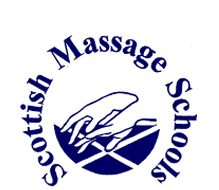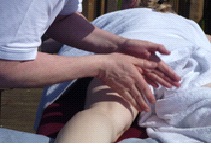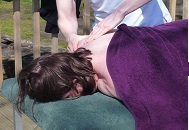Diploma in Sport Event Massage (DSEM)
Syllabus
The course builds on the knowledge and skills
gained in the Remedial course. This is evidenced in the following
ways:
Applied Anatomy & Physiology:
- Describing the structure and function of
bone and factors influencing bone health,
- Locating and identifying all bones and
superficial, palpable surface landmarks,
- Explaining the relationship between
joint structures and movement, identifying normal joint range of
motion
- Describing the structure and function of
skeletal muscle, locating and identifying superficial tendons
- Identifying the fibre orientation,
origins, insertions and actions of the major muscles in the body
- Demonstrating contraction of superficial
muscles
- Explaining exercise physiology
principles relating to athletic performance including the general
principles of training (overload, progression, specificity,
reversibility) and their consequences (training effect,
overtraining, reversibility), adaptations to exercise (skeletal,
muscular, CV, respiratory, energy systems).
Client Assessment & Treatment:
- Explaining the difference between,
benefits and uses of pre, inter, post, maintenance and
rehabilitative massage
- Demonstrating correct and appropriate
treatment in all of the above situations using a variety of
assessment techniques
- Identifying specific contra-indications
to sports massage and stating when and to whom referrals should be
made
- Describing the considerations and
equipment required for sports massage in different environments
- Designing appropriate treatment plans
that meet the specific needs of the individual athlete
- Accurately recording treatments so that they can be correctly interpreted by other medical professionals
Remedial Techniques and Soft Tissue
Manipulations
- Demonstrating correct and appropriate
use of the following techniques: basic Swedish (effleurage,
friction, petrissage, vibration, rocking, shaking, tapotement), compression,
broadening, active assisted broadening and lengthening.
- Demonstrating correct and appropriate
use of Muscle Energy Techniques on main muscle groups
- Demonstrating correct and appropriate
use of Neuromuscular, Deep Tissue and Soft Tissue Release Techniques
to identify and treat chronic muscle tension including Trigger
Points.
- Demonstrating correct and appropriate
use of basic fascial release techniques to relieve chronic tension
in the fascia.
Injury Prevention, Treatment and
Rehabilitation:
- Identifying conditions/practices that
give rise to injury and those that help prevent it
- Identifying sports injuries as acute or
chronic and when/to whom to refer
- Identifying ‘emergency’ cases
- Making the correct classification of
chronic injuries as mild, moderate or severe and describing their
treatment principles
- Explaining the mechanisms of injury
(Inflammation, proliferation, remodeling) and the role of massage
during the different phases
- Describing the stages of the
Rehabilitation Ladder (PRICER, ROM, strength – including functional
strength, speed, technical skills, force) and applying the knowledge
to simulations and/or case studies of specific injuries
- Explaining the treatment of ‘first-aid’ conditions: cramp, stitch, heat-related disorders, hypothermia, concussion, bleeding, blisters.
Please see course syllabus for more information


